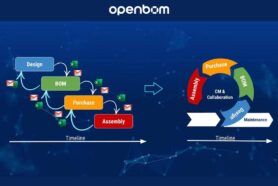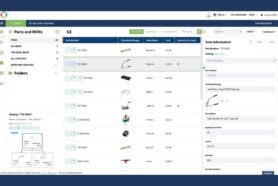
Manufacturing on demand has been a hot topic in the industry for some time now. It is seen as a way to help businesses become more flexible and responsive to changing customer requirements. In a nutshell, it comes as an online service that is capable of producing what is needed and when it is needed with the quantity, which is required.
While manufacturing is usually associated with big buildings and large investments in equipment and other assets, the on-demand model is in contrast to traditional manufacturing. Online does what you ask it to do. It is like an Uber driver that you call when you need to go from point A to point B. Or like a server on AWS that you can start when it is needed and shut down when you don’t need it anymore.
On-Demand Manufacturing and Network-based Systems
CM (contract manufacturing) can be considered as a prototype of the on-demand manufacturing model. It’s been around for a while and manufacturing companies are looking at CM model to optimize their work, scale up production volume or just offload the extra work to other facilities (in-shore and off-shore).
SaaS and CM are two things that can empower each other unlike anything else. When turned into a network these two models together can bring enormous power. It is like the 1+1=5 model when SaaS software can help to bridge manufacturing resources with manufacturing companies looking to build products. The scale factor here can help to optimize the use of equipment, provide a model to use shared manufacturing equipment, and optimize manufacturing processes.
There is a growing number of online services that are coming to turn the idea of manufacturing on demand into a reality. Here are just a few names – Xometry, Protolabs (recently acquired 3D Hubs), Fictiv, Shapeways, and some others.
On-Demand Manufacturing Foundation
Technology is one of the most important factors that can make on-demand manufacturing a reality. In my old article – One-Click Manufacturing I touched on the point that a seamless connection between engineering and manufacturing processes is absolutely important to make it happen. Build to order, speed, and engagement with consumers are the most important competitive factors. The challenge for manufacturing companies is to lower the cost of products. At the same time, customers’ demand is mass-customization, which potentially increases the cost. The speed of one click manufacturing process can change value chain economics and change the way companies will organize manufacturing processes. Guess what? Connected processes will change old-fashion PLM-ERP by streamlining communication and removing outdated siloed approaches in data management.
Nevertheless, with all the progress that on-demand manufacturing companies are doing these days, we are still in the Yahoo World Circa 1990s. The main reason for this is that the technological foundation of most engineering and manufacturing software systems are using legacy platforms that were built 15-20 years ago.
The foundation for on-demand manufacturing can only be built on top of new multi-tenant platforms capable of managing data on a global scale and integrate seamlessly with different data sources and processes online.
From PLM Systems To Manufacturing Networks
For the last 20+ years, the industry was focusing on how to build the best data management system for a single company. It was an important achievement and we’ve got scalable mature PLM platforms. The biggest problem of these legacy platforms is that they are limited to a single company and hardly can be adapted to facilitate the work with multiple companies. Even more, these systems are not designed to be platforms serving multiple other customers. Unlike legacy systems, new online services provide a way to perform work such as 3D Printing, CNC machining, and others. Online catalogs can provide a source for purchasing electronic, mechanical, and other industrial components.
At OpenBOM, we take the next step in the development of network-based PLM platforms providing services and integrating them into seamless on-demand manufacturing turnkey platforms. OpenBOM is establishing new manufacturing services.
The most important element is organizing a seamless data flow between services capable of capturing existing engineering data and delivering it in the right form to online services for the next action (eg. production). New platform strategic focus on how to provide a seamless information flow and data handover combined with the ability to develop new data analytics and intelligence around the manufacturing process, collaboration, ordering, and communication, these will be key competitive factors.
OpenBOM Web Servies
OpenBOM platform allows us to produce “process as a service” combining data with the activities needed to manufacture products. It can be used as an online service via OpenBOM.com multi-tenant platform and hosted in a customer PaaS account (eg. AWS) as a piece of the OpenBOM Web Service offerings.
OpenBOM provides an online BOM service that helps you capture engineering information, analyze it, calculate the cost, and help source and manage POs. At this point, OpenBOM is a powerful utility service that helps you collect information from multiple disciplines and connect them to a single source of truth for your project or production plan. Within time, BOM service will become smarter and will use OpenBOM platform intelligence to give you recommendations on how to optimize your sourcing and procurement.
At OpenBOM, we are looking at how to provide OpenBOM.com multi-tenant platform configured for your AWS account. Then OpenBOM administrator will be able to manage tenants and provide access to this platform for all extended enterprise users. In such a way, the OpenBOM platform admin will create tenants for the same manufacturing organization allowing contractors, suppliers, and customers to get their independent access to OpenBOM without losing control. Such configuration is available for other platforms that would like to embed OpenBOM inside their platform.
Conclusion
At OpenBOM, we provide web service information capable of providing data management services to build a manufacturing on-demand model working. As we can see a growing number of “one-click” manufacturing on-demand services, platforms will require services capable of capturing existing product design information, transforming it into a digital form, and making it available for the needs of the growing on-demand manufacturing eco-system.
REGISTER FOR FREE to check out how OpenBOM can help you and your team today.
Best, Oleg
Join our newsletter to receive a weekly portion of news, articles, and tips about OpenBOM and our community.










